Bearded dragon selective breeding has reshaped how reptile keepers view these fascinating pets. Breeders now create dragons with bold colors, rare patterns, and unique textures.
Wild bearded dragons typically blend into desert surroundings. In contrast, selectively bred dragons can appear in white, red, orange, or even translucent shades.
So, what does bearded dragon selective breeding really mean? It refers to intentionally pairing dragons to pass down specific traits—like color, scale type, or size.
If you want to understand how these morphs are developed or plan to breed your own dragons, this guide is for you. You’ll learn how bearded dragon selective breeding works, what traits to consider, and how to do it ethically and responsibly.
What Is Bearded Dragon Selective Breeding and Why Does It Matter?
Bearded dragon selective breeding is more than just pairing two colorful reptiles. It’s a purposeful process that shapes how future generations look, behave, and even thrive in captivity. Understanding its role helps owners make informed, ethical decisions.
A Brief History of Bearded Dragon Selective Breeding
Selective breeding in reptiles began to gain traction during the 1980s, especially among hobbyists interested in snakes and lizards. Early efforts focused on creating unique colors in species like corn snakes and leopard geckos. As the practice grew in popularity, it extended to bearded dragons by the 1990s. Breeders started isolating traits like color and scale type, leading to the development of distinctive morphs. Over time, the process became more advanced, with careful pairings producing consistent and desirable traits. Today, selective breeding plays a major role in reptile care and the pet industry, shaping both the appearance and genetic quality of modern bearded dragons.
What Makes Bearded Dragons Ideal for Bearded Dragon Selective Breeding?
Bearded dragons are one of the easiest reptiles to breed selectively, which makes them a favorite among reptile keepers. They reproduce well in captivity, lay multiple clutches per season, and tolerate human interaction with ease. Their visible traits—like color variation, scale structure, and eye color—are easy to track across generations. These predictable genetics make selective breeding more straightforward. Their popularity also adds value, as unique morphs are in constant demand. Compared to many reptiles, bearded dragons offer a balanced mix of genetic variety, manageable care, and reliable breeding outcomes.
Bearded Dragon Selective Breeding: Popular Traits and Morphs
Designer dragons emerged as breeders began refining specific traits through careful pairings. These traits include bold colors, clean patterns, smooth scale types, and even reduced pigmentation. Morphs such as Hypo, Trans, and Leatherback became especially popular for their standout appearances. As breeding practices improved, more complex combinations like Paradox or Zero dragons entered the market. These unique morphs weren’t just visual upgrades—they also reflected a breeder’s knowledge and reputation. Today, selective breeding continues to evolve, pushing the boundaries of what bearded dragons can look like and how they’re valued in the reptile world.
Bearded Dragon Selective Breeding and Genetic Understanding
Breeders rely on genetics to shape the look and traits of bearded dragon morphs. Understanding how these traits pass from parents to offspring helps produce consistent and healthy dragons. This section explains the basics of reptile genetics in a clear and beginner-friendly way.
Dominant and Recessive Traits in Bearded Dragon Selective Breeding
Genetics plays a key role in how morphs are passed from parents to offspring. Some traits, like the Leatherback scale type, follow dominant inheritance. This means one parent with the gene is enough to produce the trait in the baby dragon. Recessive traits, like the Hypo or Trans gene, require both parents to carry the gene for it to show. Breeders must understand this difference to pair dragons properly and get predictable results. Ignoring these rules can lead to surprises—or disappointment—in the offspring’s appearance.
How Morphs Are Inherited: A Simple Genetic Breakdown
When two dragons are bred, each contributes one set of genes. If both pass on the same trait, the baby will clearly display it. For example, two Hypo parents are likely to produce Hypo babies. If only one parent carries a recessive gene, the baby may carry it without showing any signs. These are known as “hets” or heterozygous dragons. Breeders often keep records of these traits to plan future pairings and avoid unwanted outcomes.
Genetic Terms Every Breeder Should Know
Selective breeding often involves terms like homozygous, heterozygous, co-dominant, and recessive. A homozygous dragon carries two copies of the same gene, which guarantees the trait will appear in its offspring if paired correctly. A heterozygous dragon carries one copy, so the trait might or might not show up. Co-dominant genes, like some Leatherback variations, express differently depending on how many copies the dragon inherits. Breeders who understand these terms gain more control over their breeding outcomes and produce healthier, more consistent morphs.
How Bearded Dragon Selective Breeding Works Step-by-Step
Selective breeding doesn’t rely on luck. Breeders follow a careful process to pair dragons with specific traits and goals in mind. This section walks you through each step, from choosing parents to tracking results.
Choosing Parent Dragons: Color, Pattern, and Health
Successful breeding starts with healthy and well-matched parent dragons. Breeders look for strong color expression, clean patterns, and active, alert behavior. A dragon may look impressive, but poor health or weak genetics can lead to complications in offspring. It’s important to avoid dragons with past illness, visible deformities, or signs of stress. Breeding close relatives can also increase the risk of genetic disorders, so always check the lineage. Choosing healthy dragons with desirable traits builds a strong foundation for reliable and ethical breeding.
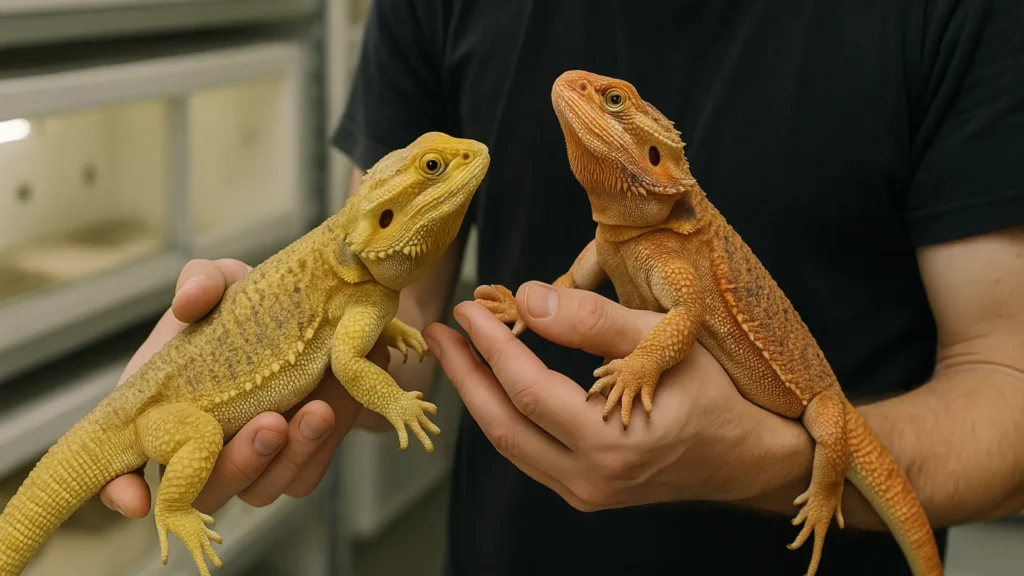
Planning a Breeding Pair: Goals and Morph Combinations
Selective breeding works best when you plan with a clear purpose. Before pairing dragons, decide what outcome you want. Are you aiming for a rare morph or refining a specific color line? Knowing your goal will guide your choices. Some traits, like leatherback or translucent, follow specific inheritance rules. You’ll need to understand which genes are dominant or recessive to get predictable results. Combining two dragons without a strategy often leads to inconsistent offspring. Planning your pair wisely increases the odds of producing dragons that meet your breeding goals.
Tracking Lineage and Genetic Outcomes Over Time
Breeding without records leads to confusion and missed opportunities. Keeping notes on each dragon’s genetics, morph type, and clutch history helps you stay organized. These records help you avoid inbreeding and let you build stronger future pairings. Over time, you’ll begin to see how traits pass down or combine in new ways. Many breeders use spreadsheets, notebooks, or even software tools to keep track. Documenting results doesn’t just improve your breeding—it also builds trust with buyers who want to know the background of their new pet.
Benefits and Risks of Selective Breeding in Bearded Dragons
It’s easy to get excited about all the stunning morphs that selective breeding can create. But behind the beauty, there’s a balance between reward and responsibility. Before diving in, it’s worth understanding both the benefits and the potential risks involved.
Enhancing Appearance: Color, Size, and Scale Texture
One of the biggest advantages of selective breeding is the ability to create eye-catching physical traits. Breeders can develop dragons with vivid colors like fiery orange, snow white, or deep red. Some dragons are selectively bred for larger size, which gives them a more impressive look. Others may have smoother or shinier scales, as seen in morphs like Leatherback or Translucent. These traits not only appeal to pet owners but also reflect careful genetic planning. The more generations involved, the more refined the appearance becomes. Selective breeding has made it possible to showcase features that would rarely occur in nature. When done responsibly, it helps expand variety and sets a higher standard in the reptile community.
Common Risks: Inbreeding, Deformities, and Weak Offspring
Despite its benefits, selective breeding comes with serious risks. Inbreeding is one of the most common mistakes new breeders make. Pairing closely related dragons can lead to birth defects, poor immune systems, and stunted growth. Some hatchlings may develop bent limbs, underdeveloped organs, or neurological issues. These problems aren’t always visible at first but can appear as the dragon grows. Weak offspring often require more care and may not survive to adulthood. Without careful genetic tracking, it’s easy to accidentally pass on harmful traits. Breeders must focus on health just as much as looks. Ignoring these risks not only harms the animals—it also damages your reputation as a responsible keeper.
Silkbacks, Paradoxes, and the Ethics of Extreme Morphs
Some morphs push the limits of what’s natural, raising questions about ethics in breeding. Silkbacks, for example, lack protective scales, which makes their skin vulnerable to injury and infection. While they may look striking, they often require constant care and special environments. Paradox dragons, with their unpredictable color patterns, are highly valued but still poorly understood genetically. These morphs can come with hidden health issues if breeders focus only on appearance. Creating extreme traits without considering the animal’s quality of life crosses a line. Ethical breeders prioritize health and function over novelty. Before producing or buying rare morphs, it’s worth asking: is this dragon thriving—or just surviving?
Beginner Tips for Ethical and Successful Bearded Dragon Breeding
Starting your journey into bearded dragon breeding can be exciting, but it also comes with big responsibilities. Before you focus on colors or rare morphs, it’s important to understand the basics of doing it the right way. This section shares practical tips to help beginners breed ethically and successfully.
How to Avoid Common Breeding Mistakes
New breeders often jump in too quickly without understanding the genetics or needs of their dragons. One of the biggest mistakes is breeding animals that aren’t fully healthy or mature. Dragons should be at least 18 months old, well-fed, and free from stress before they’re paired. Another common error is ignoring lineage. Without knowing the background of each dragon, you risk accidental inbreeding or passing down weak traits. Overcrowding hatchlings, skipping incubation checks, and failing to track morph combinations can also lead to poor results. Successful breeding starts with preparation, patience, and proper care. Taking shortcuts might save time in the moment but can lead to long-term setbacks—and unhealthy offspring.
Ethical Practices in Reptile Breeding
Ethical breeding goes beyond creating rare morphs. It means putting the animal’s health and welfare first. Breeders should avoid producing traits that harm the dragon’s quality of life, such as silkbacks, unless they fully understand and can manage the risks. Clean housing, proper nutrition, and stress-free environments are essential before, during, and after breeding. Ethical breeders also avoid selling weak or visibly unhealthy hatchlings. They educate buyers about the care needs of each morph and offer support even after the sale. Breeding with integrity not only benefits the dragons—it builds trust and credibility within the reptile community.
Frequently Asked Questions
Can selective breeding change a bearded dragon’s behavior?
While selective breeding mainly targets physical traits, it can influence temperament over time. Some breeders notice that calmer dragons tend to produce calmer babies. However, behavior is also shaped by environment, handling, and care. Genetics might set the baseline, but how you raise your dragon plays the bigger role. So yes, breeding can influence behavior—but it’s never a guarantee.
What is the rarest bearded dragon morph?
The Paradox morph is widely considered the rarest and most unique. These dragons have unpredictable splashes of color that vary from dragon to dragon. No two look the same, which adds to their value. Other rare morphs include Wero and full-body Hypo Trans morphs, but Paradox dragons remain the standout for their dramatic, one-of-a-kind appearance.
How many times can a female bearded dragon breed per year?
Most healthy females can breed two to three times per year, often laying multiple clutches per mating. Each clutch may include 15–30 eggs. While this is normal, overbreeding can harm the female. Responsible breeders allow plenty of recovery time and monitor health closely between clutches.
Is it safe to breed two morphs with the same recessive gene?
It can be safe—but only if you have a solid understanding of reptile genetics. Pairing two dragons with the same recessive gene (such as Hypo or Trans) increases the likelihood that the trait will appear in their offspring. However, some combinations of recessive genes may carry a higher risk of genetic health issues. That’s why careful research and responsible planning are essential. When done correctly, breeding for recessive traits can produce healthy hatchlings with stunning features—but cutting corners could lead to long-term problems.
Conclusion
Bearded dragon selective breeding opens the door to incredible variety—from stunning colors to rare morphs that captivate reptile lovers everywhere. But behind every eye-catching trait is a responsibility to breed with care, knowledge, and ethics. Whether you’re just starting or planning your next pairing, understanding genetics, avoiding risky practices, and putting the dragon’s health first will set you apart. With the right approach, you’re not just creating beautiful dragons—you’re helping shape a healthier, more responsible reptile community.

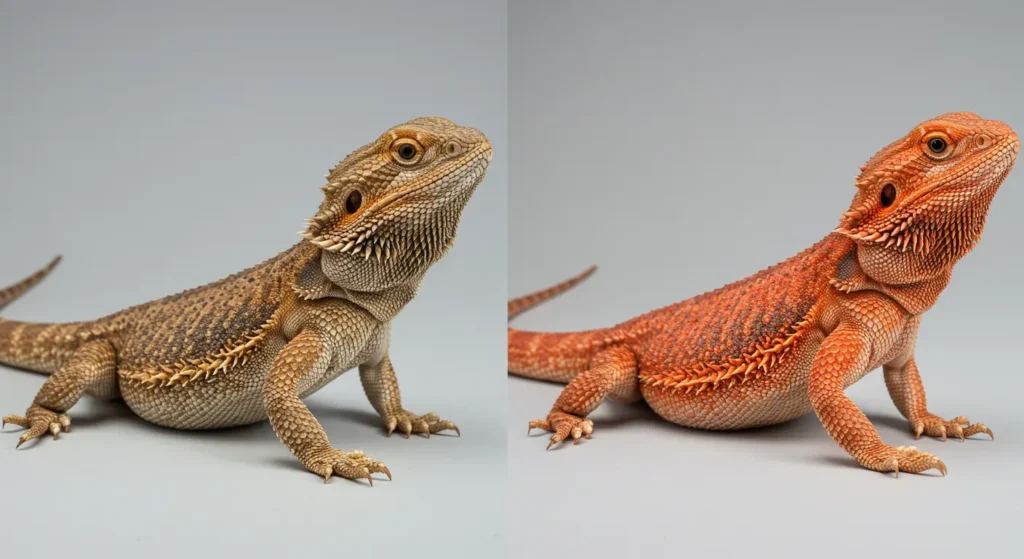
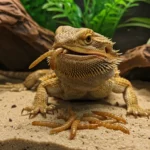
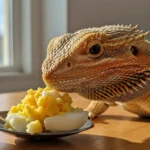
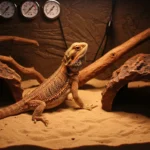
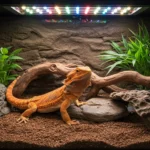
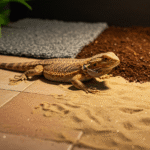
3 thoughts on “Bearded Dragon Selective Breeding: Everything You Need to Know”